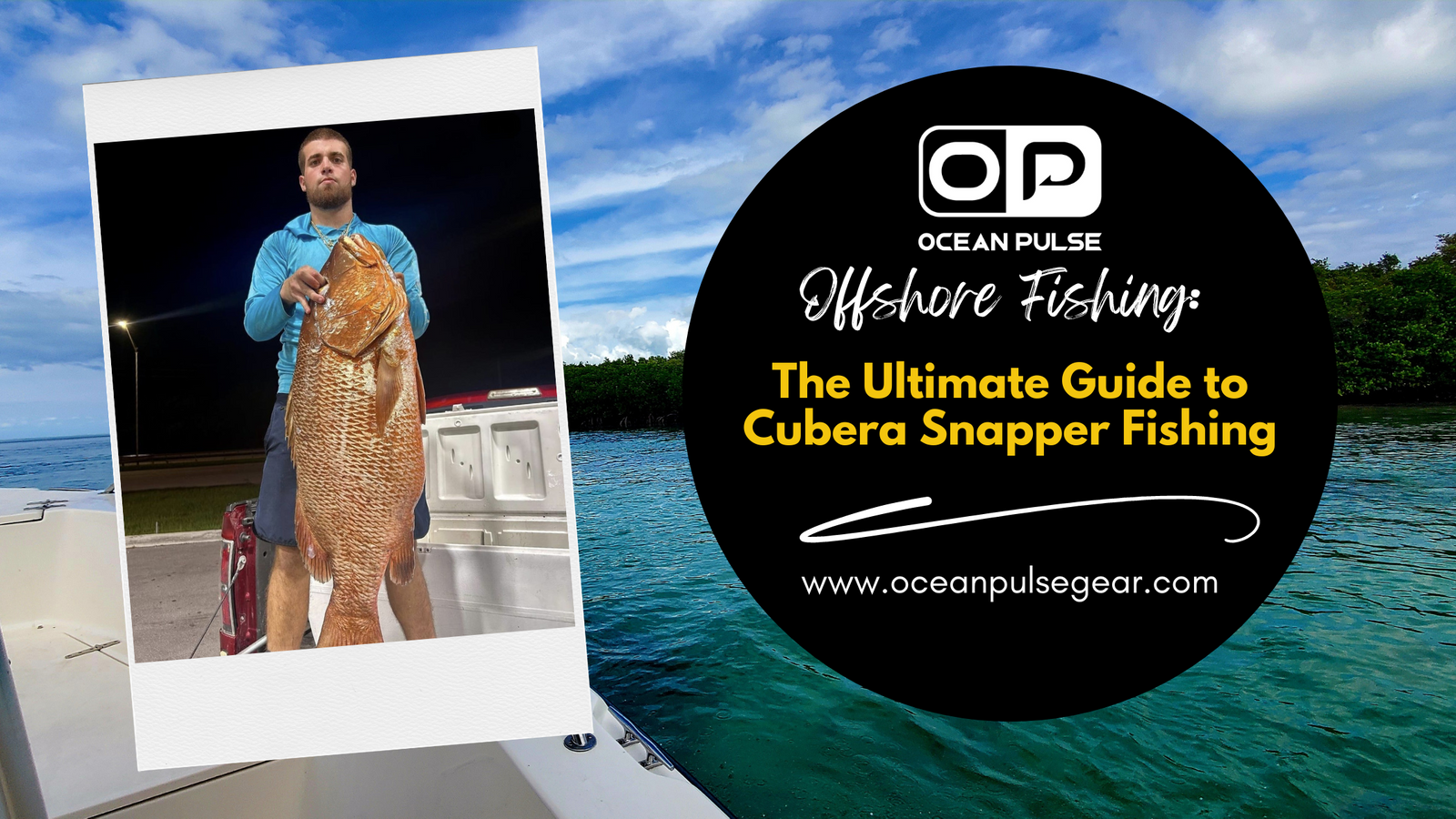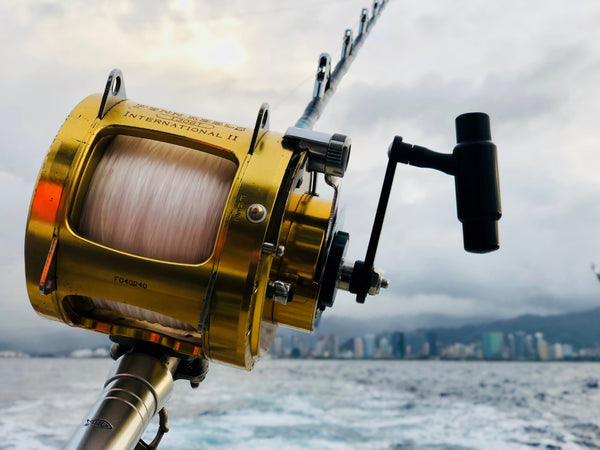Welcome to Ocean Pulse Gear, Please Enjoy Free Shipping on all orders!
Welcome to Ocean Pulse Gear, Please Enjoy Free Shipping on all orders!
The Ultimate Guide to Cubera Snapper Fishing
October 16, 2025 4 min read

How to Catch Cubera Snapper
The Cubera Snapper is the heavyweight champion of the reef. Known for their sheer power, sharp teeth, and knack for breaking tackle, these brutes test every ounce of your angling skill and gear. One moment your bait is resting quietly on the bottom, the next your rod is bent in half and the reel is screaming as a Cubera makes a run for the rocks.
Highly prized for both their fight and their flavor, Cuberas are a true trophy species in the western Atlantic and throughout the Caribbean. Few things in fishing compare to the rush of pulling a monster Cubera from a wreck under the stars.

@Svt_julito with a monster Cubera Snapper
Species: Lutjanus cyanopterus
Description: Robust, elongated body with a dark gray to brownish color, often showing a red or bronze tint. Large mouth with sharp, canine-like teeth and a spiny dorsal fin.
Size Range: 20–40 inches (average), up to 63 inches (maximum)
Weight Range: 20–50 pounds (average), up to 125+ pounds (maximum)
Life Span: Up to 55 years
Habitat and Behavior
Cubera Snapper are structure-loving predators. They haunt wrecks, reefs, and rocky ledges where smaller fish and crustaceans are abundant. Juveniles often hide among mangroves before moving offshore as they grow.
-
Typical Habitat: Coastal reefs, wrecks, rocky bottoms, and mangroves
-
Depth Range: 60–250 feet
-
Feeding Style: Aggressive carnivore feeding on fish, crabs, squid, shrimp, and lobster
-
Seasonal Patterns: Active year-round, with peak activity during the summer spawning season
Gear and Tackle Recommendations
Cuberas are notorious for testing the limits of your gear. To have any chance of turning one, heavy-duty setups are a must.
-
Rod and Reel: Heavy bottom-fishing or jigging setup with strong drag and backbone
-
Line Type and Strength: 80–130 lb braided line for strength and sensitivity
-
Leader: 80–130 lb fluorocarbon leader to resist abrasion and remain less visible
-
Hook Size: 8/0–12/0 circle hooks
-
Weights: 8–16 oz sinkers to keep baits tight to the bottom
-
Pro Tip: Check your drag often. Set it tight but smooth to keep a hooked Cubera from reaching structure and cutting you off.
Bait Selection
When hunting big Cuberas, presentation and bait quality make all the difference.
-
Preferred Baits: Live grunts, pinfish, lobsters, and blue runners are top choices
-
Cut Baits: Fresh squid, mullet chunks, or bonito strips
-
Artificial Lures: Heavy metal jigs and large deep-diving plugs that mimic wounded fish
-
Presentation Tips: Drop baits naturally and stay in constant contact with the bottom. Keep live baits lively and avoid excessive movement that may spook fish
-
Bait Freshness: Always use fresh bait. Cuberas can be selective, and fresh scent draws more strikes
Fishing Rigs
Heavy structure calls for strong, simple rigs that can handle abuse.
-
Fish-Finder Rig: Sliding sinker on the mainline tied to a swivel, followed by 3–4 feet of 80–130 lb fluorocarbon leader and an 8/0–12/0 circle hook
-
Knocker Rig: Egg sinker slides directly above the hook, ideal for presenting baits close to the bottom with minimal resistance
-
Sliding Sinker Rig: Sinker runs on the mainline above a swivel with a short mono section and 3–4 feet of fluorocarbon leader
Effective Fishing Techniques
Bottom Fishing
Bottom fishing remains the classic and most effective way to target Cubera Snapper.
Steps:
-
Use a fishfinder to locate reefs, wrecks, or rocky structures.
-
Deploy a heavy-duty rod and reel with 80–130 lb braid.
-
Choose a sinker heavy enough to stay on the bottom, usually 8–16 oz depending on current.
-
Drop live or cut bait directly over the structure.
-
Keep contact with the seafloor and monitor for subtle bites.
-
When you feel a hit, apply firm pressure and reel hard to pull the fish away from cover.
Jigging
Vertical jigging can trigger Cuberas that ignore traditional baits.
Steps:
-
Use heavy metal jigs capable of reaching bottom quickly.
-
Drift or anchor over rocky bottoms or wrecks.
-
Drop the jig and work it with a steady rhythm.
-
Mix up your jigging speed to find what triggers strikes.
-
Stay ready for hits on both the fall and retrieve.
Night Fishing
Many of the largest Cubera Snapper are caught after sunset, especially during summer spawning periods.
Steps:
-
Anchor near known spawning reefs or wrecks.
-
Use live baits such as grunts, lobsters, or large pinfish.
-
Drop baits to the bottom and maintain steady contact.
-
Pay attention to subtle line movements.
-
When the bite comes, set the hook and apply constant pressure to keep the fish clear of structure.
Tips for Consistent Success
-
Positioning: Anchor or drift near reef edges and wrecks.
-
Hook Setting: Let the fish commit before applying full pressure.
-
Adaptability: If bites slow down, try switching bait species or adjusting sinker weight.
-
Persistence: Cuberas often strike when you least expect it, so stay patient and alert.
Best Time of Year to Catch Cubera Snapper
Cubera Snapper fishing peaks in summer, particularly during the full moons of July and August when large groups gather to spawn offshore. Nighttime offers the best shot at true giants, though smaller fish can be caught year-round in shallower reefs.
Conservation and Regulations
These fish grow slowly and live long lives, so proper handling and harvest limits are critical.
-
Size and Bag Limits: Follow current state and federal rules, which may vary by region
-
Sustainable Practices: Release undersized fish carefully and avoid overharvesting during spawning events, and make sure to have a descending device available for fish showing signs of barotrauma.
-
Tackle Ethics: Use circle hooks to minimize deep hooking and reduce injury
Local Knowledge and Expert Advice
Experienced captains agree that the first few seconds of a Cubera fight decide the outcome. The key is to pull hard immediately after the hook set and keep steady pressure until the fish is clear of structure. Many anglers lose their fish by hesitating or giving slack.
Common Challenge: Cuberas are notorious for breaking lines against sharp rocks or wrecks, so use abrasion-resistant leaders and check them after every battle.
Conclusion
Cubera Snapper fishing is not for the faint of heart. It demands strength, patience, and a respect for one of the ocean’s toughest predators. With the right preparation and persistence, landing one of these giants becomes an unforgettable achievement that every serious angler should experience.
Leave a comment
Comments will be approved before showing up.

Become an OP VIP, sign up for exclusive discounts offers and event coverage.
Sign up below!
